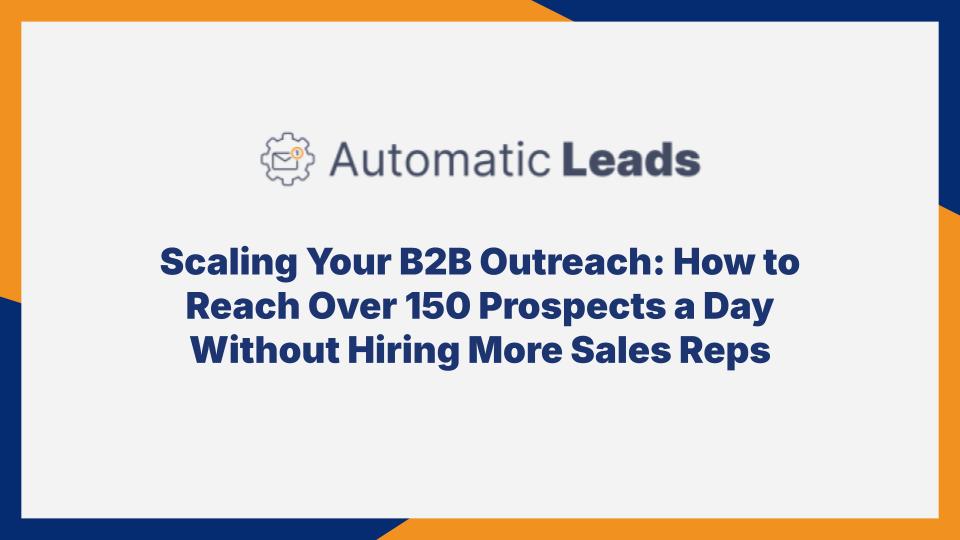For many B2B companies, one of the biggest challenges in sales is scaling outreach efforts to consistently reach a large number of prospects.
While hiring more sales reps can increase capacity, it’s often costly and time-consuming.
The good news is that there’s a more efficient solution: automated outreach systems.
By implementing these systems, you can scale your outreach to over 150 prospects a day without expanding your sales team.
Here’s how to make it work for your business.
Understanding Automated Outreach Systems
Automated outreach systems are platforms that streamline and automate the process of contacting and engaging with potential customers.
They allow you to set up sequences of personalised messages that are sent automatically to a targeted list of prospects, saving your sales team the time and effort of manual outreach.
The system typically involves:
- Automated Email Sequences: A series of pre-written emails tailored to your target audience that can be sent out over a specified period.
- Multi-Channel Outreach: The ability to reach prospects through various channels, such as email, social media, and even SMS, depending on where they are most active.
- Data Collection and Tracking: Insights into open rates, response rates, and engagement levels, which help refine your approach and improve results over time.
By leveraging these tools, your business can effectively increase its daily outreach without requiring additional resources.
The Benefits of Scaling B2B Outreach with Automation
- Increased Reach and Consistency
- With automated systems, you can reach a much larger number of prospects than is possible with manual outreach alone. By contacting over 150 prospects daily, you can ensure that your message consistently reaches potential customers, creating a steady pipeline of leads. This also reduces the risk of peaks and valleys in your lead generation, making your sales process more predictable.
- Time Savings for Your Sales Team
- Automated outreach systems handle the initial stages of prospecting and engagement, freeing up your sales team to focus on more complex tasks, such as building relationships with qualified leads and closing deals. This increased efficiency enables your team to spend more time on high-impact activities that drive revenue.
- Cost-Effectiveness
- Expanding your sales team to reach more prospects can be costly. With automated outreach, you can achieve similar results at a fraction of the cost, as the system can handle a large volume of outreach without the need for additional personnel. This approach allows you to maximise your budget and allocate resources more strategically.
- Personalisation at Scale
- Although the outreach is automated, you can still personalise your messages. Automated systems can pull data from your CRM to include details such as the prospect’s name, company, and even specific industry insights. This helps make your messages feel more relevant and targeted, increasing the likelihood of a positive response.
- Data-Driven Optimisation
- Automated systems provide valuable insights into your outreach efforts, including which messages are resonating with prospects and which are not. By analysing this data, you can continuously optimise your messaging, timing, and targeting to improve engagement and conversion rates over time.
How to Implement an Automated Outreach System
- Identify Your Target Audience
- Start by defining your Ideal Customer Profile (ICP). This includes specifics such as industry, company size, location, and decision-maker roles. The more precise your targeting, the more effective your outreach will be.
- Craft Personalised Messaging Sequences
- Create a series of messages that address the needs and pain points of your target audience. Include a mix of content, such as introductory emails, follow-ups, and educational resources. Each message should provide value and guide prospects closer to a conversion.
- Choose the Right Channels
- Depending on your target audience, consider which channels are most appropriate for your outreach. Email is often the primary channel, but you may also consider LinkedIn or other social media platforms for additional touchpoints. Multi-channel approaches can increase engagement and help you reach prospects where they are most active.
- Set Up and Schedule Your Sequence
- With your messages ready, set up the sequence within your automated outreach platform. You can control the timing between messages to ensure prospects receive them at optimal intervals. Start with a welcoming message, followed by a series of tailored content, and include calls-to-action (CTAs) that encourage the next step, such as scheduling a call or downloading a resource.
- Monitor and Optimise Performance
- Once your sequence is live, monitor the performance metrics closely. Analyse open rates, click-through rates, and response rates to identify areas for improvement. Use this data to refine your messaging, adjust timing, and experiment with different CTAs for better results.
Making the Most of Automation
Automated outreach systems are a powerful tool for scaling B2B sales efforts, but success depends on continuous refinement and a well-planned strategy.
Start small, test various approaches, and make adjustments based on performance data.
By doing so, you can optimise your system and maximise the benefits of reaching a large number of prospects daily.
Scaling outreach through automation allows you to build a consistent pipeline of leads, reduce the burden on your sales team, and ultimately drive more growth for your business.
With the right approach, you can effectively expand your reach, engage more prospects, and achieve your sales goals without the need to hire additional sales reps.

